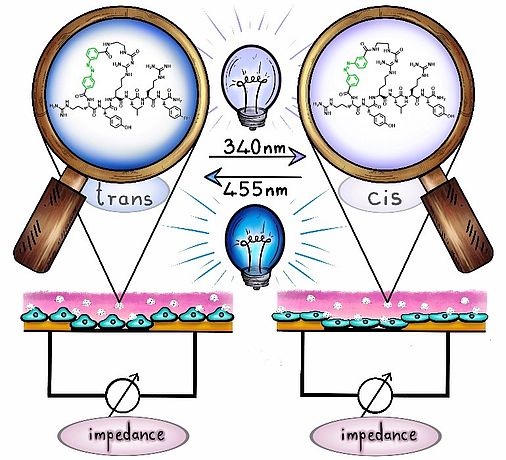Controlling Cells with Light
Interdisciplinary research team at UR develops molecular photo-switches to control cell physiology
31 May 2023
An interdisciplinary research team from the Institutes of Organic Chemistry, Analytical Chemistry and Pharmacy at the University of Regensburg has developed molecules that change their molecular structure when exposed to visible light and thereby steer the activity of cell-surface receptors. If this switching occurs while the molecules are bound to their receptor, the corresponding cell reaction is switched on or off by irradiation with visible light. The signaling cascades within the cells can thus be controlled externally by light.
The cells of the human body must be able to respond quickly and in a coordinated manner to hormones and other chemical messengers. A fundamental mechanism for mediating such cellular responses is based on the activation of cell surface receptors. These proteins on the cell surface specifically recognize extracellular signaling molecules. If binding between the receptor and the messenger occurs, the associated minimal deformation of the receptor transmits this information to the interior of the cell and triggers a signaling cascade. Among all known cell surface receptors, the so-called G-protein coupled receptors (GPCR) represent by far the largest family.
The human genome has at least 800 genes that encode such receptors. Well-known examples are the receptor for the stress hormone adrenaline, the receptor for dopamine or the histamine receptor, which plays a major role in allergic reactions. Due to this large number and their fundamentally important function in mediating information into the cell interior, it is not surprising that malfunctions of GPCRs are associated with a variety of diseases and that these receptors are targets of many drugs. Although estimates vary somewhat, approximately 40% of all prescription drugs today target these GPCRs to influence their function and alleviate disease symptoms.
An interdisciplinary research team from the Institutes of Organic Chemistry, Analytical Chemistry and Pharmacy at the University of Regensburg has now developed molecules that bind to and activate the so-called neuropeptide Y receptor (NPY). The special feature of these molecules is that they change their molecular structure (trans versus cis) when induced by visible light, and the two forms differ significantly in their effect on the NPY receptor. This is made possible by a so-called photoswitch built into the molecule, which reversibly changes the shape of the entire molecule when irradiated with visible light. If this switching occurs while the molecules are bound to the receptor, the corresponding cell reaction is switched on or off by visible light. The signaling cascades within the cells can thus be controlled externally by light.

Photoswitchable ligands of cell surface receptors are switched between two states by visible light (340 nm or 455 nm) without contact. The resulting controlled signal cascades lead to cell shape changes that can be detected very sensitively with impedance measurements. Credit: Julia Erl/UR
Until now, there have been only a few experimental options to follow cell reactions controlled by photoswitches in real time. This was mainly caused by the fact that most techniques to observe cells are themselves based on light, resulting in unwanted interference with the switching of molecules. The UR research team resolved this limitation by growing the cells of interest on thin-film electrodes and tracking the cell response before, during, and after switching in real time using electrochemical impedance measurements. Impedance measurements in this embodiment are very sensitive indicators of cell shape changes as triggered by the signaling cascades in the cell resulting from receptor activation by the photoswitchable molecules. This combination of controlling biomolecular activity with light and observing it by impedance measurements will be applied to other receptors and signaling cascades in the future.
Information/Contact
The research paper was published in the March issue of Angewandte Chemie (International Edition) in open access format:
Ulrike Wirth, Julia Erl, Saphia Azzam, Dr. Carina Höring, Dr. Michael Skiba, Ritu Singh, Kathrin Hochmuth, PD Dr. Max Keller, Prof. Dr. Joachim Wegener, Prof. Dr. Burkhard König: Monitoring the Reversibility of GPCR Signaling by Combining Photochromic Ligands with Label-free Impedance Analysis. https://doi.org/10.1002/ange.202215547
PD Dr. Max Keller (Pharmacy)
Prof. Dr. Burkhard König (Organic Chemistry)
Prof. Dr. Joachim Wegener (Analytical Chemistry)




